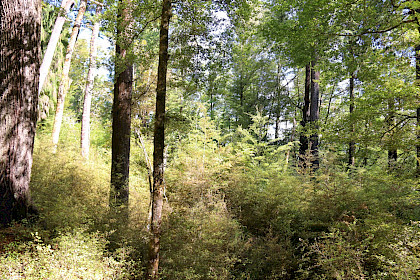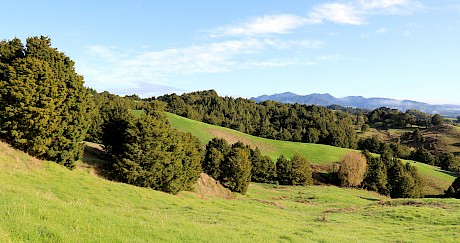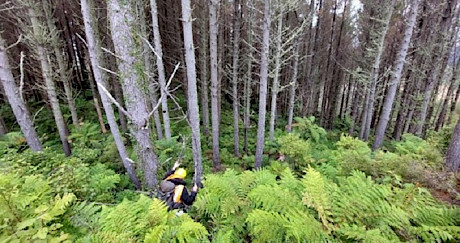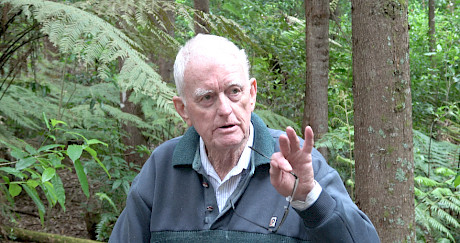Cost-effective planting and reversion scenarios for establishing native forests - factsheetsProject Status: Current
Introduction
A new factsheet series is almost completed and will be available on the Tāne’s Tree Trust website to download by the end of 2023. The series is funded by the MPI’s Billion Trees Programme to provide the latest information on a range of site-specific, low-cost planting and regeneration scenarios that are required for establishment of permanent native forest, especially for scaling up the establishment of native forestry across marginal, pastoral hill country.
Factsheet content
The factsheets provide the latest information and best-practice guidelines on establishment and early management of native forest for multiple objectives, targeting landowners, community groups, iwi and the general public. Factsheets topics cover both planting and managing natural regeneration.
A brief summary of the first factsheets is provided.
Why plant natives
Tens of millions of native trees and shrubs are being planted annually throughout New Zealand by various agencies, landowners, iwi, and community groups. Reasons for planting include enhancement of native plant and animal biodiversity for conservation; establishment of native cover on erosion-prone sites; improvement of water quality by revegetation of riparian areas; and management for production of high-quality timber.
Large-scale planting of natives is being undertaken in urban and rural areas in many regions, supported by local authorities, iwi and community groups. Most visible are the large areas along roads and motorways planted in a wide range of native species. Other planting programmes are evident beside rivers and streams where natives are planted in fenced-off riparian areas.
The basics of planting natives
Planting nursery-raised seedlings is the most widely used option for the establishment of native forests, planted to meet many objectives. It allows control of the species mix and density of planting, and with appropriate after-planting care, can be highly successful. Planting is, however, an expensive and labour-intensive method for establishing natives so getting the basics right is paramount.
Planting requires a substantial commitment of time and resources. Identifying factors that are likely to reduce success such as browsing animals that need to be controlled. Also, exploring opportunities to assist natural reversion to complement planting is recommended.
Seed collection for native trees and shrubs
Most native forest restoration programmes rely on planting nursery-raised seedlings of a selection of shrub and tree species. Many projects involve planting thousands of seedlings where the vast majority of plants are raised from seed.
Collection of seed by individuals, skilled seed collectors and native plant nurseries requires a knowledge of the species including seeding characteristics and timing of seed maturity, and skills in collecting, storage and treatment before sowing. Seed collection, handling, storage and germination are described in this factsheet for the more commonly planted native shrubs and trees raised in nurseries for restoration planting programmes.
Ecosourcing of native species for planting
Ecosourcing is defined as the sourcing of seed (or vegetative material) from nearby natural populations to propagate native planting stock for planting in the same locality, i.e., collection of seed from wild populations that are as close as possible to the area being planted. Issues with ecosourcing include defining the boundaries for local provenances for different native species, lack of local seed sources including fragmented and rare species, and assurances from nurseries that they are providing ecosourced stock.
While ecosourcing should be included in the planning stages of native plantings, recommendations are provided for a pragmatic approach to incentivise the adoption of ecosourcing principles in raising and planting natives for multiple purposes.
Site preparation for planting natives
Good site preparation is critical for successful establishment of native forest. Site preparation covers a multitude of tasks that need to be addressed before the site is planted. These tasks will vary from site to site. This factsheet covers the requirements for preparing a site for planting native trees and shrubs including fencing to exclude domestic grazing stock, pest animal control, and management of existing vegetation cover.
The prescription for, and intensity of, site preparation is influenced by site characteristics, scale of planting, resources available including labour, quality and size of planting stock, and intended density of planting.
Getting ready for planting
Before the planting spade hits the ground, there are important issues to consider when planning a native planting project, whether you are planting a few natives for a community-based restoration project or establishing native forest on a large scale.
This factsheet covers the basics of preparing a planting project on-the-ground, essential to both small and large planting programmes. Aspects include whether the planting project is to be undertaken by community volunteers or by contract planters, options for planting time, transporting and storage of plants at the planting site, and methods for laying out plants to achieve the desired planting pattern for tree spacing and species mix.
How to plant native seedlings
Good planting techniques are essential to the success of any planting project whether establishing a few natives in a garden or at a larger scale as part of a restoration project or establishing a native forest plantation. If planting is not done properly, it is inevitable plants will become unthrifty, unstable or even die - wasting time, money and effort.
This factsheet provides a list of equipment required for planting and covers the basics of good planting methods for small or large planting projects. This includes checking root systems of planting stock, good planting technique, options for marking and protecting seedlings after planting, and use of fertilisers and mulches.
Right species right place
An understanding of ecological requirements of each of the native tree species and restoration sites will allow matching of appropriate species to suitable sites. This approach that follows local successional pathways is more likely to mimic the often slower natural regeneration processes and lead to good early performance.
There is considerable variation in the ecological requirements and site preferences for native species. Some require shelter in early years on open sites to improve growth while others tolerate specific site conditions such as greater moisture levels. Planting native species at random through an area is unlikely to match species to most suitable sites and therefore will probably compromise overall performance.
Natural regeneration of native forests
Regeneration or reversion of native forest is the process by which land reverts either naturally, or with human assistance, to a vegetation cover dominated by native species. Natural regeneration is promoted and partially funded by the One Billion Trees (1BT) programme where active management is undertaken by the landowner.
This factsheet considers the opportunities to work with nature to establish native forest. While the success of regeneration can be site-specific, there are options for landowners to encourage regeneration of native forest. Successful regeneration requires a nearby seed source, birds to spread seed, and typically involves exclusion of livestock by fencing, control of animal pests, and where necessary, selective control of potentially aggressive and persistent brush weeds such as blackberry. Supplementary planting is another management option that can speed up regeneration.
How to establish “seed islands” of natives
Establishing ‘seed islands’ across landscapes is a method for using small target planting areas to assist nature to establish diverse native forests at scale through natural regeneration. It is a pragmatic and cost-effective option, given the high cost of planting natives at $20,000 (or more) per ha, and the impracticality of intensive blanket planting, especially on a large scale.
The aim is to plant intensively managed small groves of native trees to provide greater diversity of wind- and bird-dispersed seed across the wider regenerating or more sparsely planted landscape. Intensively managed seed islands focuses time and resources to ensure greater success of planted groups of natives at small scale by high density planting using tall well-conditioned seedlings, providing extra shelter species if required, reducing pest animal browsing, ensuring timely weed control, and where practical, undertaking control of predators of rodents and mustelids to boost bird populations and seed production of natives. 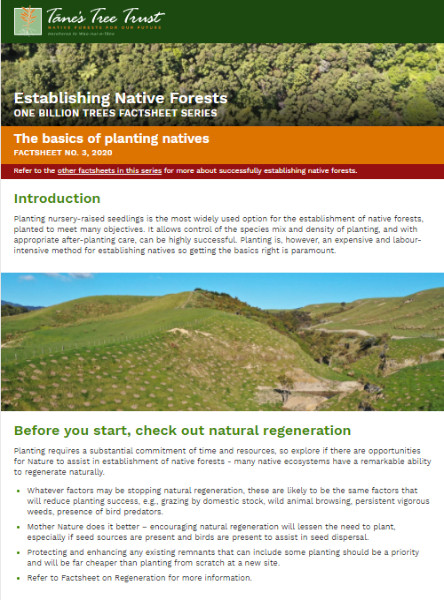
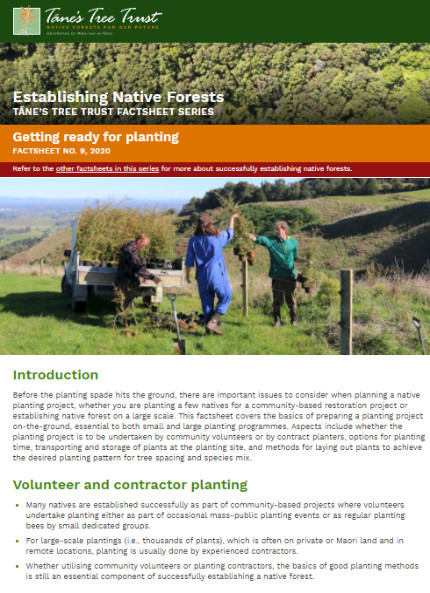
Planting nurse species – the concept of succession
Mature indigenous forest develops in multiple steps, with each step providing the conditions that will suit the next group of plants. The first step in forest restoration is to establish suitable native coloniser plants, often referred to as nurse species, which will cover the site quickly and shade out grass and weeds.
The process of recolonising a bare patch of land (either naturally or via human intervention) is called ‘succession’. During the succession process, early colonising species creates conditions suitable for the establishment of other later successional species. It takes many years for the process of succession to transform an area from bare land to a mature forest. Coloniser species, sometimes called pioneer species, grow on open sites as they can cope with the extremes of local climate during the establishment phase.
Establishing a woodlot of native trees
Many native tree species have excellent potential for plantation management to produce timber. Woodlots of key native timber trees will give optimum growth in single or mixed-species plantations if they are established on sites that suit their ecological characteristics and are managed appropriately.
Sustainable harvesting plans can be designed to ensure that the non-timber values of planted native forest will be preserved using continuous cover forestry principles. This involves harvesting only a small proportion of the stand at a time, leaving the high forest structure and associated environmental values intact. 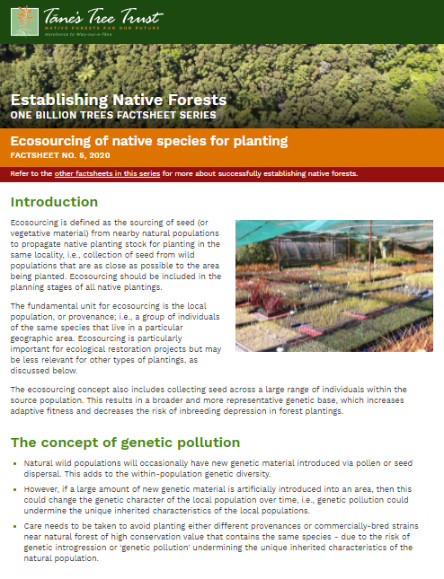
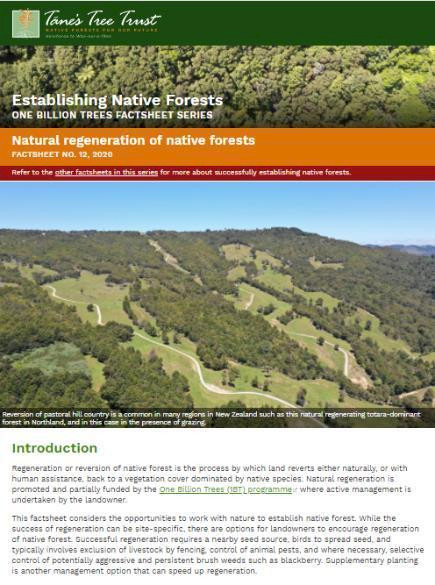
Selecting the right stock
The use of strong, healthy planting stock is critical to the success of any planting programme. And planning is vital. Seed must be collected from the best sources and nursery stock raised for the particular programme well ahead of the planting season. A variety of plant grades and container types are available, as described below, with application to operational-scale planting.
Most of the information presented here is based on experience rather than on comparative experimental trials. Factors that should be considered before planting include relative suitability of bare-rooted and container-grown stock; appropriate plant size and quality; and the type and size of containers.
Maintenance of planted natives
For a period of more than a century, hundreds of thousands of native tree seedlings have been planted with the aim of establishing a native forestry resource. A nationwide survey of native tree plantations identified suppression by grasses and herbaceous weeds, ground ferns, and exotic scramblers and shrubs or brush weeds as the main cause of poor survival and slow growth.
Only a fraction of the planted stands have survived to the present day and most do not reflect their true potential in terms of survival and growth rates. While existing stands bear evidence of poor matching of species to site, the vast majority of failures and poor performance of planted natives is due to the lack of maintenance – for the most part, timely and adequate weed control.
Establishing logged exotic forest with natives
There is increasing interest in landowners who have recently, or are about to, clearfell stands of radiata pine and want to replace them with a permanent native forest. These are at all scales from small 1-2 ha blocks to substantial areas owned by iwi, some well over 1000 ha. Most stands are radiata pine and other exotic conifers but there are also a range of exotic hardwood stands such as eucalypts, willows and poplar.
This factsheet covers the issues landowners need to consider when contemplating converting an exotic stand, that has been managed and clear-felled as a productive timber crop, to a permanent cover of native forest. The focus is on a clear-felled site where the merchantable logs have been removed; the option of manipulating a standing semi-mature or mature pine stand by partial felling or other options such as poisoning to slowly open up the canopy to allow native understorey or interplanted natives to take over is not considered in this factsheet.
Monitoring success of planted and regenerating natives
Most native planting projects are focused on planting, and few follow up with monitoring other than a cursory glance that hopefully most planted natives have survived and beaten the weeds. Planting trees is only the first step toward establishing new areas of native forest.
Monitoring early survival and growth of your plantings will provide you with valuable insights into what is working or not. It will help you schedule in timely weed and pest animal control and enable you to learn from any failures.
Councils and some community groups are very keen to see a more formal quantitative approach, but few have the skills, resources or practical methods to undertake monitoring, so it is hardly ever carried out. This factsheet outlines the options for monitoring newly planted native forest. Natural regeneration is increasingly being promoted for large scale establishment of native forest and some insights into monitoring of natural regeneration are also provided.
Building resilient new native forest with expected impacts of climate change
Internationally, there is growing evidence that climate change is causing changes to weather patterns, including increasing temperatures and changing rainfall patterns. The expansion of forest resources is a major means of countering climate change, concurrent with reductions in emissions, but there is major concern at the effects of increasing drought, increased fire risks and in some cases forest dieback.
This factsheet looks at the predicted changes for our climate and how this is likely to impact existing forest and the establishment of new native forest in New Zealand. Then it considers measures required to make our native forest more resilient, including planting in drier regions, preparing for more frequent and severe wildfires, and protecting native forest against pests and diseases.
Management of plantations
Many native tree species show excellent potential for plantation management to produce timber. Woodlots of key native timber trees will give optimum growth as part of single or mixed-species plantations – if they are established on sites that suit the ecological characteristics of their species and they are managed appropriately. Those planting native trees for multiple reasons are establishing a resource where future generations have the option to manage for extraction of high-quality, high-value specialty timber from appropriate sites.
Sustainable harvesting plans can be designed to ensure that the non-timber values of planted native forest will be preserved using continuous cover forestry principles. i.e., only a small proportion of the stand is harvested at a time to leave the high forest structure and associated environmental values intact.
Acknowledgements
Critical to the success of this project has been the project partners including Cassie’s Farm, Pāmu Farms, Te Kohaka o Tuhaitara Trust, Mahurangi Action Inc, Longbush Ecological Trust, Scion, AUT, regional councils and the Northland Tōtara Working Group.

